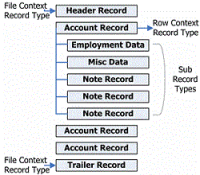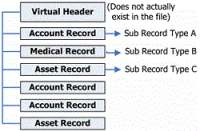- Contents
Exchange Manager Help
Source File Layout
Use the Define Import Layout window to define delimited or fixed import file layouts so that you can map the layouts to fields in the Latitude database. Optionally, you can use an Excel file to define the import file layout. You can create this file or Latitude by Genesys can provide it.
Exchange Manager imports files sequentially. When establishing parent and child relationships between records, reference file layouts sequentially unless each record contains the unique account identifier that associates it to the correct Latitude account record.
Note: If the import file is a standard Excel file (one record per row), you do not need to define the source file layout. On the New Business, Financial Transactions, Maintenance, or Final Recall tab, select the Uses Excel check box and proceed to Import File Mapping.
Hierarchical File Layout
Exchange Manager recognizes multiple record files using hierarchies. Define the row context (parent record) and all other records as subs (children) of the row context. If Exchange Manager doesn't locate the unique account identifier in a sub record, Exchange Manager creates the field. The field inherits its value from the previous row context record in the file.
The following example illustrates a typical flat file layout (fixed or delimited) where the sub record types can inherit the unique account identifier from the account record. Multiple sub records of the same name can appear for the same account.

Virtual Headers
Exchange Manager uses a virtual header when there is no record that Exchange Manager can set as the context record. The following example illustrates how Exchange Manager uses a virtual header to create a relationship for multiple, stand-alone records. In this file, multiple record types exist and each contains unique account identifiers.




